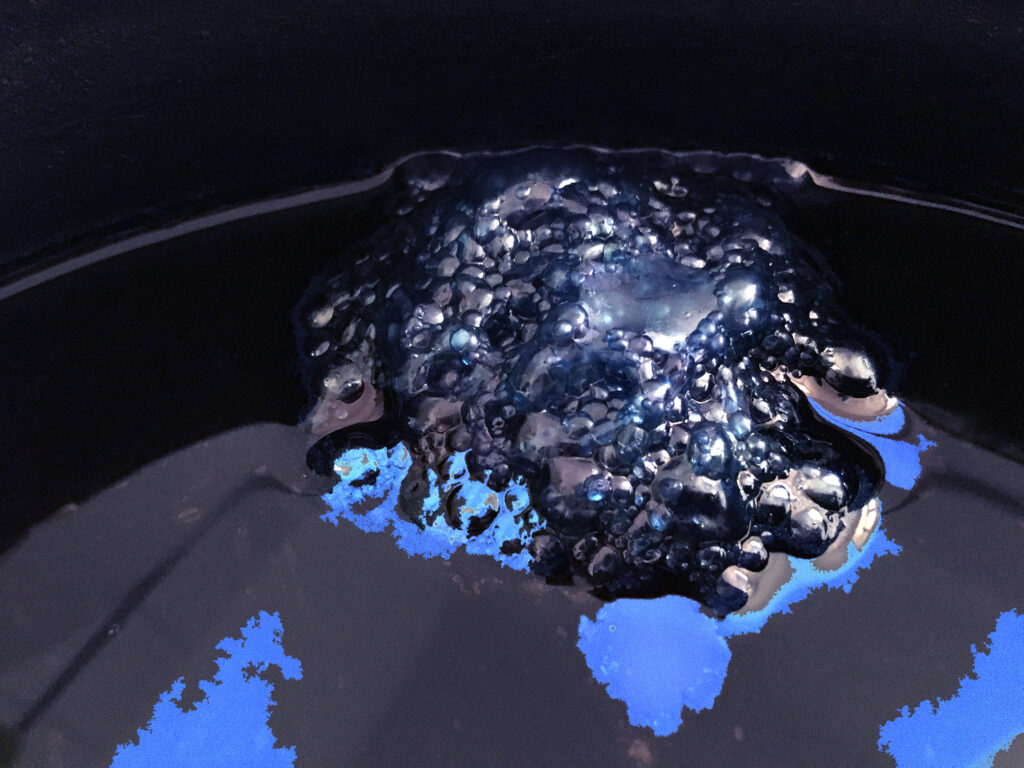
Froth of the Unknown ai
Reflections on discoveries from June 2 – 5, 2025
How do the three choreographic qualities we’ve teased out, affect ‘who is moving’ when the body moves? ‘Me’ or something moving ‘me’?
Wobble: the movement that might be more internal, neurological. Perhaps it something like internal spontaneous movements of a baby. I link this to the ‘dance of darkness’ what Hijikata was trying to achieve with what he called Ankoku Butoh. The body is not moving to the music or responding to it the sound is purely ambience and holding space. Improvisation / freedom space.
Words: these are not really formed words but they have the quality of the nonsense words that Natsu was using in the classes. ‘Words’ sounds have more of a sense of staccato and attack. They sound very different to the wobble. They seem to come up when the bell is rung (interestingly): bells are used in rituals of every culture and normally they signal a change of mental space from the everyday to the sacred which is required for rituals. The words create a challenge for movement the challenge of reacting with immediacy (as Moe Yamamoto told me), between an internal and external spontaneous movement
Repetition: if I let my body move rhythmically to a repetition, the dance becomes something like the way people dance at a rave. This is what makes them go into a trance state sometimes. I had a feeling that I couldn’t stop. I could continue and I can imagine that that would put me in a trance. This is a purely externally induced movement.
In Tantra there is the idea that sounds are connected with the kundalini awakening which has a sonic quality:
“there are certain signs that suggest that kundalini has been awakened: bodily heat increases, sweating occurs copiously; there are all over the body, sharp sensations like scorpion bite, and so on. But the urge to continue the exercise is so imperative that after this stage one does not usually give up. As one perseveres, however, these signs give way to more abstract and less distracting signs. It is interesting that these are at first essentially vigourous auditory hallucination, like sounds made by the sea at a distance, peels of thunder, and the roar of the waterfalls. Then the sounds become softer and more pleasant: jingling and tinkling of ornaments worn on the body, the soft strains from a hand drum, the muffled sound from a handbell, the musical notes from a lute or flute. Find me the sound becomes exceedingly subtle, like the humming of a bee.” Tantra, Mantra, Yantra: The Tantra Psychology
Sometimes the interactions between the three voices and the way I am playing with them or guiding them is comical. It’s a great reflection process on how humans ascribe meanings to things they don’t understand. The one who is self-confident enough to say that he, and it’s normally a ‘he’, understands what nobody else does, is the one who gets power, starts a religion, a political party, etc. though he doesn’t really understand.
What if people who hear voices just have an ability to hear vocal tonalities in the landscape just as some people, I being one of them, hear entire sound compositions in the whirring of fans, washing machines, hair clippers, etc? The AI is turning the landscape of sound into vocal tonalities for the human ear.
Is the question, really about Hijikata’s choreography? He wanted Butoh to be a form of revolution to Westernization and capitalism, and he resorted to using his voice in order to pass this ‘activism’ to others in his Butoh-Fu. But his voice of protest was poetic, associative, sensorial. And his students were never allowed to ‘wobble’, they focused on only ‘words’ and ‘repetition’; wobble belonged to the sixties.